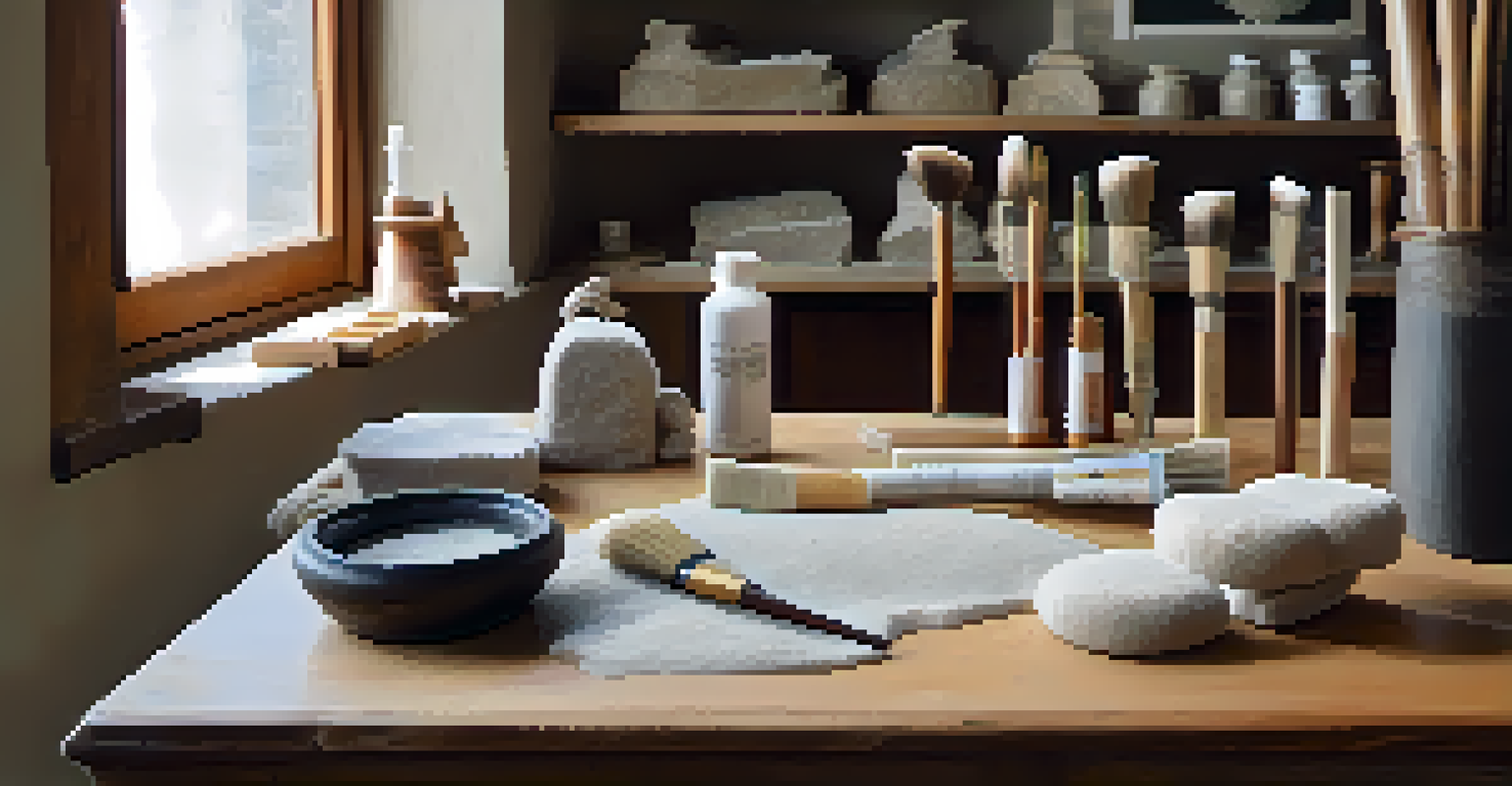Guidelines for Cleaning Stone Carvings Without Damage

Understanding Your Stone Carving's Material
Before diving into cleaning, it's crucial to identify the type of stone your carving is made from. Common materials include marble, granite, and limestone, each with unique properties. For instance, softer stones like limestone can be more susceptible to scratches and damage than harder stones like granite.
Cleaning is not just about getting rid of dirt, it's about preserving history.
Knowing the stone type not only helps in selecting the right cleaning methods but also informs you about potential vulnerabilities. For example, acidic cleaners can harm marble but are often safe for granite. This understanding sets the foundation for effective and safe cleaning.
To avoid mishaps, consider consulting a professional or researching the specific characteristics of your stone. This initial step ensures that you approach the cleaning process with the right knowledge, preventing accidental damage.
Gathering the Right Cleaning Supplies
Having the right tools at hand is essential for a successful cleaning session. You'll need soft brushes, microfiber cloths, and a gentle cleaning solution, preferably pH-neutral. These items will help avoid scratching the surface while effectively removing dirt and grime.

Avoid harsh chemicals or abrasive materials, as they can lead to irreversible damage. For instance, steel wool might seem effective, but it can leave scratches that mar the beauty of your stone carving. Instead, opt for natural, non-acidic cleaners that are safe for your specific stone type.
Identify Your Stone Type First
Understanding the material of your stone carving is crucial for selecting appropriate cleaning methods and avoiding damage.
Once you have your supplies ready, take a moment to prepare your workspace. Ensure that the area is free from debris and that you have adequate lighting, which will help you see any areas that need extra attention during the cleaning process.
Testing Your Cleaning Method on a Hidden Area
Before applying any cleaning solution to the entire surface, it's wise to test it on a small, inconspicuous area. This practice can reveal any adverse reactions from the stone, such as discoloration or damage. Think of this step as a 'trial run' to ensure you won't be shocked by an unexpected outcome.
The beauty of stone is that it lasts forever, but it needs care and attention to maintain its charm.
Choose a spot that is hidden from direct view, like the underside or back of the carving. Apply the cleaner gently and wait for a few minutes to see how the stone reacts. If all goes well, you can proceed confidently to clean the rest of the piece.
If the test spot shows any signs of damage, it's better to halt and rethink your approach. This caution will save you from potentially costly repairs or the need for restoration later on.
Gentle Cleaning Techniques for Stone Carvings
When it comes to cleaning, less is often more—especially with delicate stone carvings. Use a soft-bristled brush or a damp microfiber cloth to gently wipe away dirt. It’s akin to petting a cat; you want to be gentle yet effective, avoiding any forceful scrubbing that could harm the surface.
For stubborn stains, dampen the cloth with a mild cleaning solution and gently blot the area rather than rubbing. This technique helps lift the stain without scraping the stone. Think of it as a gentle hug for your carving, allowing it to stay intact while still getting clean.
Use Gentle Cleaning Techniques
Employ soft brushes and pH-neutral solutions to clean your stone carving, ensuring you treat it delicately to maintain its beauty.
Always remember to rinse with clean water after using any cleaning solution. This step removes any residue that could attract more dirt in the future. A final wipe with a dry microfiber cloth can also help restore the stone's natural shine.
Dealing with Stains on Stone Carvings
Stains on stone carvings can be a real headache, but many can be tackled with simple solutions. For organic stains, such as those from food or drink, a paste made from baking soda and water can work wonders. Apply it to the stained area, let it sit for a while, and then gently scrub it off.
For oil-based stains, you might need a poultice—a mixture that draws out the stain. Combine a white absorbent material like flour with a solvent suitable for your stone type. Spread it over the stain, cover it with plastic wrap, and let it sit for a day or two. This method may sound complicated, but it’s like giving your carving a spa treatment.
Always finish with a thorough rinse to ensure no cleaning agents are left behind. This final step is crucial in maintaining the integrity and appearance of your stone carving.
Maintaining Your Stone Carvings After Cleaning
Once your stone carving is clean, it's important to maintain it to prolong its beauty. Regular dusting with a soft cloth can prevent dirt buildup, while periodic gentle cleaning can keep it looking fresh. Think of it as a regular grooming routine for your beloved piece.
Consider applying a stone sealer every few years, especially for porous stones like limestone. This protective layer can help repel stains and moisture, acting as a barrier against the elements. Just like sunscreen protects your skin, a sealer protects your stone.
Seek Professional Help When Needed
For large or valuable carvings, consider hiring experts for cleaning and restoration to preserve the integrity of your piece.
Storing your stone carvings in a controlled environment, away from direct sunlight and moisture, can also help. This protective measure ensures that your carvings remain in great shape for years to come.
When to Seek Professional Help for Cleaning
Cleaning stone carvings can be a delicate task, and sometimes it's best left to the professionals. If your carving is particularly large, ornate, or valuable, consider hiring an expert who specializes in stone restoration. This decision can save you time and potential heartache.
Professionals have access to specialized tools and techniques that can ensure a thorough yet gentle cleaning process. They can also address any underlying issues, such as cracks or chips, that you might not notice. Think of them as the doctors of the stone world, diagnosing and treating problems with precision.

If you're unsure about the cleaning process or if your stone carving has sentimental value, don't hesitate to reach out to a professional. Their expertise can help maintain the integrity and beauty of your cherished piece.